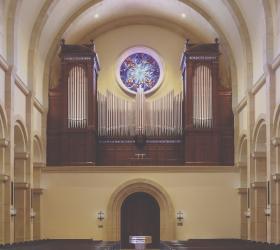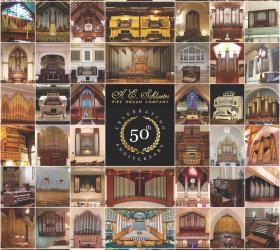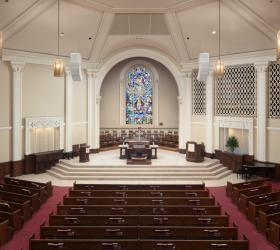
Dobson Pipe Organ Builders, Lake City, Iowa
St. Dunstan’s Episcopal Church, Carmel Valley, California
Dobson Pipe Organ Builders of Lake City, Iowa, has built its Opus 94 for St. Dunstan’s Episcopal Church in Carmel Valley, California. The church’s spare yet handsome building, designed by parishioner Mel Blevens of Holewinski Blevens Fedelem & Lukes Architects in 1963, accurately reflects a parish of modest means but artistic vision. Never intended to house a pipe organ, St. Dunstan’s had been served by an increasingly cranky electronic organ. Fitted with carpet, inadequate lighting, and pews stained the color of asphalt, the church was no longer the most visually or aurally welcoming space. Dobson’s design of an organ standing front and center encouraged the parish to beautify its worship space and enliven its acoustic by removing the carpeting and staining the concrete floor, refinishing the pews, and installing new LED lighting. The revised altar platform, now deeper and constructed of concrete rather than noisy plywood, is sheathed in stone quarried near Jerusalem. A new communion rail and ambo complete the chancel.
Standing behind all this, the organ makes a sensitive statement, drawing attention to the front of the space rather than overwhelming it. To accommodate the choir, seated to one side of the chancel, the organ console is placed on that end of the instrument. From this location, the organist can easily give direction to the choir and remain abreast of activity in the nave. The angled geometry of the building called for a similarly non-traditional visual design. The speaking front pipes of burnished tin make a bold, sweeping gesture, echoed by slotted openings in the organ case that permit additional sound egress. The arc of the front pipes is anchored by wooden ones that stand along the left side of the instrument. The instrument’s white oak case is crowned by a sheltering roof whose slope parallels the ceiling above. A simple Latin cross stands at the front of the instrument, honoring an earlier cross of similar design that was displaced by the chancel renovation.
Steven Denmark, director of music, had long dreamed of the new organ’s tonal design, and together we explored many stoplists. His thinking was dramatically affected by a 2014 visit to the organ in St. Michael’s Abbey in Farnborough, England. Installed in 1905 and attributed to Charles Mutin, the organ appears to contain older elements built by Mutin’s master, Aristide Cavaillé-Coll. Set within a small but acoustically stunning Gothic revival chapel, this organ of only fourteen voices makes an unforgettable impression.
Encouraged by the possibilities on display in the Farnborough organ, essentially a one-manual instrument divided over two keyboards, the design of Opus 94 took a new turn. Though improved and now proportional to the space, the acoustic of St. Dunstan’s church building is but a pale shadow of that at Farnborough. However, a foundation-rich design as exemplified by the Farnborough organ is not only an appropriate response to a less-reverberant room but also a musically responsible choice for a parish with a traditional choral program. In Opus 94, nine of the manuals’ fifteen stops are of 8′ pitch. For dynamic flexibility in both accompaniment and literature, the Plein Jeu and manual reeds stand within the Récit enclosure. Denmark felt strongly that some sort of Jeu de tierce registration should be present. There is no precedent in the work of Cavaillé-Coll for an independent Tierce, and when a stop of 22⁄3′ pitch was included, it was always a Quinte. We elected to make both mutations as flutes with strongly ascendant trebles so that they function well with the principal-toned unisons. A 16′ Bourdon shared between Grand-Orgue and Pédale is a feature of most Cavaillé-Coll choir organs that I didn’t feel we could replicate here; the poor bass response of the church dictates a scale and treatment for the Pédale that would have muddied any manual texture.
Despite its modern appearance, the instrument is laid out in a traditional way, with the Grand-Orgue standing immediately in front of the Récit. The Pédale Bourdon pipes are painted our customary “Dobson red.” Most of the pipes in the organ were built in our shop; the pipes of high tin alloy—the façade pipes, the strings, and the reeds—are the work of Killinger in Freiberg am Neckar, Germany. All are voiced on a wind pressure of 70 mm, regulated by a large, weighted, single-rise reservoir. The mechanical key action is balanced, running from the console to transverse rollers just above the floor that are fitted with crank arms for the pulldowns. While not an historic feature, the coupling manual offers useful registrational possibilities beyond the common II/I coupler. An electric stop action and 100-level combination action are provided. Mechanism is present for the eventual installation of a Pédale 16′ reed.
The organ was dedicated on November 15, 2015, with Steven Denmark at the organ. Inaugural year programs have been presented by Angela Kraft Cross, James Welch, Thomas Joyce, Tiffany Truett, and Kimo Smith.
The Interfaith Forum on Religion, Art, and Architecture presented this organ with an award in the category of Religious Art: Liturgical Furnishings. The award was announced in the Winter 2016 issue of Faith & Form magazine.
Dobson Pipe Organ Builders
William Ayers
Abraham Batten
Kent Brown
Lynn Dobson
Randy Hausman
Dean Heim
Donny Hobbs
Ben Hoskins
Arthur Middleton
John Ourensma
John Panning
Kirk Russell
Bob Savage
Jim Streufert
John Streufert
Jon Thieszen
Pat Thieszen
Sally Winter
Randall Wolff
Dean Zenor
COUPLING MANUAL (I)
GRAND-ORGUE (II)
8′ Montre
8′ Salicional
8′ Flûte Harmonique (bass from Bourdon)
8′ Bourdon
4′ Prestant
22⁄3′ Nasard
2′ Doublette
13⁄5′ Tierce
RÉCIT EXPRESSIF (III, enclosed)
8′ Viole de Gambe
8′ Voix Céleste (FF)
8′ Cor de Nuit
4′ Flûte Octaviante
III Plein Jeu 2′
8′ Trompette
8′ Basson-Hautbois
Tremblant (affects entire instrument)
PÉDALE
16′ Soubasse
8′ Bourdon (ext 16′)
16′ Bombarde (preparation)
8′ Trompette (ext 16′)
G.-O./Pédale
Récit/Pédale
Manual/Pedal compass: 58/32
18 ranks




